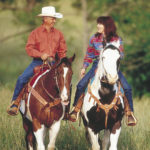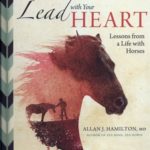Raising a posse-sized cloud of dust, I stood in the stirrups of my western saddle, jammed my Australian bush hat lower over my eyes and gave Grey Wolf his head. This was his turf; he could make the decisions. Through a blur of sagebrush I glimpsed rough ground and gopher holes ? and decided not to look down again. Fanned out around me were eight other riders in full gallop and whooping with delight.

We finally reached the top of a ridge and stopped, our horses stamping and blowing from their run. Grinning, I caught my breath, taking in the pungent smell of crushed sage, and looked around. In every direction lay hundred-mile vistas of sky and open country unmarred by power lines, buildings or roads. After a bit of excited chatter, we all fell silent, each of us caught in our own thoughts.
As a youngster growing up horseless in the Southeast, I had pored over western magazines and dreamed of galloping through sagebrush on a spirited cow pony. I saw every western movie twice and was inordinately proud of having the same first name as Roy Rogers’ wife, Dale Evans.
This western fixation lasted until I was about 17, when I discovered the joys of English-style riding and jumping. I went on to devote more than two decades to training and showing hunters and jumpers professionally, with no regrets.
Then an invitation to a week-long ride in Wyoming revived the latent cowgirl in me. Here I was at last, galloping through the sagebrush on a pretty gray Arab. It had taken most of a lifetime, but I was finally living my dream.
My friend and I chose this particular ride because it was for women. Having participated in women-only sailing trips, we anticipated that the group dynamics would be very different than if we were on a co-ed ride. Women tend to ?let their hair down,? literally and figuratively, in the absence of males. Comfort becomes the main criteria for dress and hairdos. Women ?bond? quickly and conversations are often intimate and candid. Quite unlike a group of men, they are more likely to be supportive of each other rather than competitive.
Even though it was a women-only trip, the outfitter made it clear that this was no beginners? ride. It would be geared to riders with enough experience to canter comfortably and manage six hours a day in a western saddle over rugged terrain. Our accommodations would be basic–tents and sleeping bags–but with gourmet meals from a well-equipped chuckwagon.
Wyoming, the ?Equality State?
The location of the week-long ride was also a deciding factor?the wild and beautiful Big Horn Basin of Wyoming. Wyoming was a symbolic location for the ride, having been the first state to give women the right to vote and own property in a marriage. Our wrangler and cook had anecdotes to tell us about pioneer women of the ?Equality State,? from ?soiled doves? (prostitutes) to missionaries to the country?s first female justice of the peace. We would be riding in an area once frequented by women such as the legendary Calamity Jane, a consort of Wild Bill Hickock; and Wanda Savage, a turn-of-the-century sharpshooter and movie stuntwoman.
Our group of eight arrived in Lander, Wyoming, from different directions, with different equestrian backgrounds, and different expectations. For the sisters who lived on opposite coasts, it was a splendid reunion and a chance to ride again after many years. Two of the Californians, a teacher and a banker, spent most weekends as mounted park rangers, but wanted a change of scene. Also from California was the nursing instructor, recently widowed for the second time and hoping to renew her damaged spirit. The intensive care nurse from Wisconsin, who graciously accepted the nickname “Garbo,” sought time alone, but not too far from our companionship. My Virginia friend and I were looking for adventure in the company of like-minded women.
We met our horses at the end of a gravel road that was once the main wagon trail into the Big Horn Basin. Bound on the south, east and west by the forbidding Wind River Mountains, the huge bowl was one of the last places in the state to be settled. (To my East Coast eyes, country where main roads are gravel is still wonderfully unsettled.) We spent the afternoon getting acquainted with each other and our mounts, and spent our first night in the teepee-style tents.
I woke early, my body still on Virginia time, and tied back the flap of our tent to watch dawn bring up the house lights. Our camp occupied a spectacular spot atop Cottonwood Pass, higher than the rest of our immediate world, with a dark smudge of mountains on the far horizon.
Backlit by a salmon-colored sky, our wrangler moved quietly among the horses. We had warmed quickly to her for her horsemanship, her humor and her easygoing nature ? critical elements in a person responsible for showing us a good time while keeping everyone safe. She had grown up in Texas, but put her riding on hold to earn an art degree and go climbing in Nepal before settling down to wrangling ?dudes? like us. Having an educated, sensitive woman as our wrangler enhanced the experience, whereas a male would have caused us to temper our mildly risqu remarks and fireside confidences, not to mention our skinny-dipping when we camped by water.
With the first scents of coffee and bacon, the camp stirred. Women’s voices rose on the air, culminating in a “Come and get it!” from our cook. I grabbed my hat, straightened my bandana and, as an afterthought, tossed my wristwatch into my duffle bag.
Clustered around the breakfast table, we forked scrambled eggs and peppers into tortillas with unladylike gusto. Our cook wrought culinary magic in the back of her motorized chuck wagon, and hauled all of our gear. When we rode into a new camp at the end of each day, our tents and the portable john were set up, and hors d’oeuvres and chilled wine were waiting. Dinners ranged from beef burgundy, barbecued chicken and stir fry to grilled steaks, all with lots of creative side dishes and fresh blueberry pie or cheesecake for dessert. Hopes of losing weight on the ride were dashed early on.
On the Trail
Every morning we rolled our lunches into raincoats, tied them behind our saddles, and rode out. There was no agenda and no real schedule beyond getting to our next camp in time for dinner. We stopped to explore old agate mines (depressions in the ground with shiny bits of agate poking through the dust), and sagging settlers’ cabins with bits of broken furniture and pottery, and the occasional rose bush persevering among the wild flowers. We sometimes lingered over lunch in what had been someone?s front yard, and pondered what it would be like to live here, miles from other people.
The August sun was hot, but the air was so dry that perspiration evaporated before it had a chance to be sticky. I was grateful for my chapstick and the canteen of tepid water tied to my saddle horn. I poured a little on the bandana around my neck, feeling ever so cowboy-ish, and pulled my hat lower over my eyes. (I had refused to wear sunglasses like some dude, and had assumed a parody of a Clint Eastwood squint.)
The western saddle grew familiar and comfortable, as did Grey Wolf’s stride, the short but smooth motion of an Arab crossbred. He also had the fire of his breed and a penchant for tossing his head, but I forgave him that. His mouth was light and he moved over rough ground like a dancer.
The other riders adjusted quickly to their mounts, too. All of the horses were lively but well-mannered, the sort you could drop your reins on without fear. And surefooted! Over eons, water had carved the plains into deep draws and steep, rocky cliffs which our horses took in stride, walking along the edge of precipices as if they were strolling through a park. We followed more than one trail that was little more than a foot-wide groove cut into a 45-degree slope. Without hesitation our horses tucked their haunches and slid down into ravines, then scrambled up the opposite side as we grabbed mane and let them have their heads. When we reached open plains, the horses seemed to enjoy a good gallop as much as we did.
To save our horses? energy, we often moved at a walk or easy trot under a huge blue bowl of sky. We passed herds of cattle and sheep, and antelope sometimes skittered away at our approach, but the gophers that dug all the holes seemed to be vacationing elsewhere.
Wyoming ? and Ourselves ? Unveiled
We talked constantly when the going was easy, riding two or three abreast, always with Garbo off to the side like an outrider watching for Indians, and silently vanquishing her own demons in her own way.
The intensive care nurse brought us to tears with her story of losing two husbands ? real soulmates — to lingering illnesses. ?I can’t believe I told you my life story,? she said afterwards. ?I?ve never really talked about it before, but now that I have, I think perhaps the healing has started.?
We discovered an incredible coincidence in the group ? three of the women had been young children in Pearl Harbor during the Japanese attack, and shared vivid memories of the experience.
We talked about our horses, cats, dogs, husbands, children, houses and jobs; favorite books and movies; our fears; our vision for the world and ourselves. We talked until I felt that we had fast-forwarded from casual acquaintances to lifelong friends, and that our lives had been enriched in the process.
We rode all of one day in a constant dusty wind that whipped words from our mouths and caused us to ration the water in our canteens. When we arrived at our camp on Battle Mountain, we found the portable john tied to an old post. It had blown over twice ? unoccupied, fortunately. Our tents flapped and rumbled just yards from a precipice overlooking Badlands-type terrain. A tribe of Indians had been massacred by the cavalry on this spot, and I heard their ghosts that night in the howling wind.
As the days passed, we became accustomed to the terrain and the 150-mile vistas, and began to notice small things. Along the trail grew Queen Anne’s lace, yarrow, and tiny wild blue astors, daisies and buttercups. Sometimes our horse trod on wild mint, and the scent rose to blend with the smell of sage. We skirted dished out areas ? ancient buffalo wallows where the great beasts had once taken dust baths.
On Lightning Ridge the skeleton of a mother antelope and her baby lay beside the trail. We speculated about the balance of nature and imagined pioneers pausing beside human remains on their journey west. Descending into a green valley, we tied up our horses and climbed a cliff face to examine ancient petroglyphs. In the shelter of an overhang, the drawings of horses and men seemed as clear as the day they were drawn. I wondered whether they had some solemn significance or were simply the work of children killing time on a hot summer’s day.
After a particularly dusty day on the trail, three of us hiked to a small watering hole to skinny-dip. I noticed a white ring around the sides where the water had receded, but realized too late that it was caused by alkali. By the time we got back to camp, the water had dried white on our skin and our hair stuck out like broomstraw, much to the amusement of our cohorts.
The next night we camped by a real swimming hole on the Nowood River and swam in a cold pool of mountain water beneath bluffs of red sandstone. I was inclined to explore the caves in the cliffs until I learned mountain lions lived there. That night we sang songs around a campfire as a full moon rose over the lip of our canyon. The next morning we learned that the cook had been awakened by the smell of coyote during the night, and watched a pair wander through camp looking for scraps. Our lunch break the following day was on the brink of Deep Creek Canyon, where colorful, sheer walls plummeted 1,000 feet to an unseen river. When we mounted up to leave, I again gave Grey Wolf his head. He calmly followed the narrow path that lay perilously close to the edge. For a while I forgot to breathe.
That afternoon we raced a storm rolling dark and thunderous across the plains, shot through with bolts of lightning. The ground seemed to open before us, and we dropped down into the shelter of a small canyon carpeted in thick grass and shaded by aspens. It was the sort of place we’d usually explore, but the rain made us hurry on to reach camp at the bottom of Cherry Creek Hill. The storm rumbled through quickly, settling the dust and leaving a sunset as brilliant as the roaring fire we built to chase the chill.
I said my goodbyes to Grey Wolf the next day. The others did the same, and we all tried not to show how attached we’d become to our horses ? and each other. Our wrangler put our feelings into words: “People from different jobs and different lives find themselves on common ground here. We’re not so different. We all have ties to the planet that nurtures us and when we get back to the land we find that life is really simple. We all want the same things–to eat, sleep and ride a good horse.”
Before dinner I had rescued my watch and put it on, not missing the symbolism of the act. There were planes to catch and deadlines to meet in my real world. But for a time I’d lived my childhood dream. Best of all, I knew I could do it again anytime I wanted to fly to Wyoming–and leave my watch behind.
When you go
Wyoming’s climate can fluctuate from the high 80s to the 40s, so take a lightweight down jacket or vest. If you’re sensitive to the sun, pack long-sleeved cotton shirts and sunscreen. By mid-morning I usually shucked my long-sleeved shirt and rode in the sleeveless t-shirt I wore underneath. Rainfall is only 12 inches a year, but take non-bulky rain gear just in case. Don’t forget your bathing suit.
Outfitters usually provide tents and thick foam pads; guests bring their own sleeping bags and towels.
Helmets are not required on most Western rides, and most of us rode in cowboy hats or baseball caps for protection from the sun. Make sure your hat has a cord so it won’t blow away.
Water on the trail is a necessity, but don’t buy one of those western canteens. They look good, but it takes two hands to hold one and remove the cap, and the water tastes metallic. A large biking water bottle is ideal for one-handed drinking and is easy to tie to the saddle horn.
A fanny pack is handy for carrying small items such as sunscreen, lip balm, eyedrops, a pocket knife, or a bit of string in case something breaks.
By all means, pack light. You’ll be lugging your bag (make it a soft-sider or duffle) to the chuckwagon every morning. Because the humidity is low, you’ll need fewer changes of clothes than you think. A sweatshirt and sweat pants will do for nightly camp wear.
Outfitters:
We rode with Belinda Daugherty, who has over 25 years of experience in the area wrangling dudes and now has her own company. Go to renegaderides.com.







